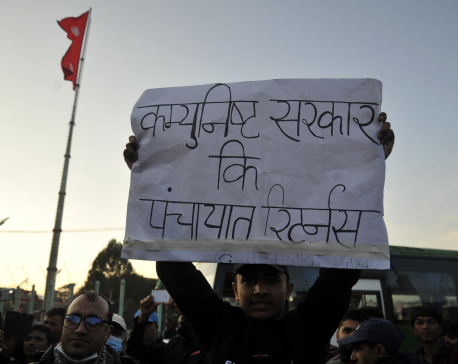
OR
Where are the disappeared?
Published On: September 1, 2019 02:30 AM NPT By: Republica | @RepublicaNepal
Friday marked the International Day of the Disappeared, the day to draw the attention to the fate of individuals whose whereabouts and conditions are unknown to their relatives and legal representatives. It is observed with various programs on August 30 every year. In Nepal, it unleashed unpleasant memories of those who disappeared during the decade-long Maoist insurgency (1996-2006). Stories of people recounting circumstances of their relatives’ disappearance surfaced in the media. All these stories are painful. Take this one from Rolpa. Dil Kumari Roka, now 48 years old local of Thawang, lost her husband Dhan Bahadur Roka, who was a radio journalist in 2001. She knows nothing about him. Dhan Bahadur Roka, an employee of Radio Nepal at the time, was abducted by Maoists. At the time of his disappearance, Roka had returned to Liwang, district headquarters of Rolpa, to meet his family. When he was heading to Surkhet, Maoists abducted him on the way. Dil Kumari remembers her husband deeply but she is giving up hope that he will ever return. She suspects that Maoists killed him then. Then there is Omsara Sunar, 40, whose son (15 at the time) was abducted reportedly by [then Royal] Nepal Army. Omsara does not know where her son is, whether he is alive.
These are only representative stories. As a matter of fact, families of around 3,300 people who were disappeared by the state forces and Maoist rebels during the insurgency have such painful stories to tell. By all measures, the decade-long insurgency was the period of agony for people of Nepal. There was a danger of being arrested by security forces in charge of protecting the Maoist rebels if the locals provided them shelter. And if they did not provide shelters to the Maoists, the rebels would subject them to inhuman cruelty and torture, even death. The innocent locals, including the journalists, became the victims of the conflict between the state forces and the rebels. So 13 years after the Maoists joined the mainstream politics, hundreds of people are still living with the memories of deaths and disappearance. Some went missing while going to collect fodder in the nearby forests, others would be caught by security forces or the Maoist rebels while going to visit their parents and relatives from towns. If all memories are documented, perhaps it would make volumes.
Politically, many things changed in Nepal after the Maoist war. Monarchy was abolished and the country became the federal democratic republic. The new constitution was promulgated in 2015 and the party that launched the violent revolt against the state is now leading the government. But when it comes to addressing the concerns of the victims of the disappeared, the state, it must be said, has done literally nothing. The transitional justice mechanisms—Truth and Reconciliation Commission (TRC) and Commission of Investigation on Enforced Disappeared Persons (CIEDP), the latter meant to address the demands of the families of the disappeared—are now defunct. The government has not been able to reconstitute these bodies nor appointed officials to accomplish the tasks of identifying the whereabouts of those who disappeared. The incompetence on the part of the government on this front is making the mockery of the plight of the families of the enforced disappeared persons. This level of insensitivity from the state side is truly perturbing. The families of the 3,300 disappeared persons have lived with agony for more than a decade. It’s already getting late for the government to find the whereabouts of the disappeared and tell them the truth.
You May Like This

Do not obstruct justice
As the victims of the decade-long insurgency (1996-2006) are voicing their grievances against the government for failing to provide them... Read More...

Heed public outrage
It’s deeply troubling that the government of K P Sharma Oli is displaying authoritarian tendencies through a number of steps... Read More...

CIAA, keep the momentum
Commission for the Investigation of Abuse of Authority (CIAA) has upped its ante in investigating cases of corruption and irregularities. Read More...







Just In
- NRB to provide collateral-free loans to foreign employment seekers
- NEB to publish Grade 12 results next week
- Body handover begins; Relatives remain dissatisfied with insurance, compensation amount
- NC defers its plan to join Koshi govt
- NRB to review microfinance loan interest rate
- 134 dead in floods and landslides since onset of monsoon this year
- Mahakali Irrigation Project sees only 22 percent physical progress in 18 years
- Singapore now holds world's most powerful passport; Nepal stays at 98th











Leave A Comment